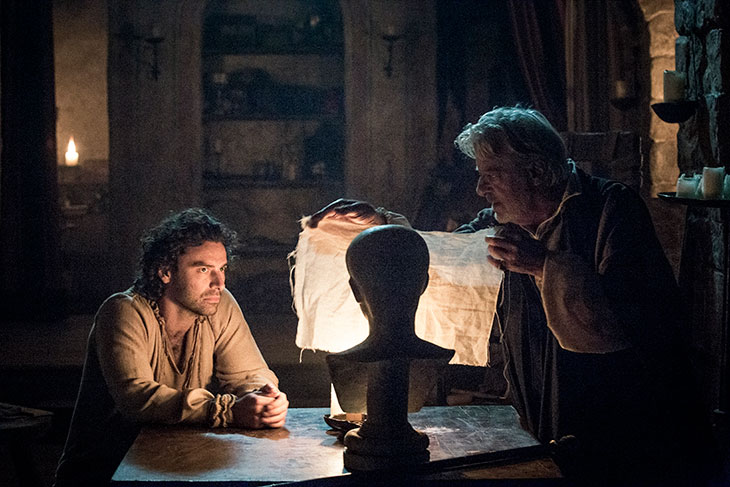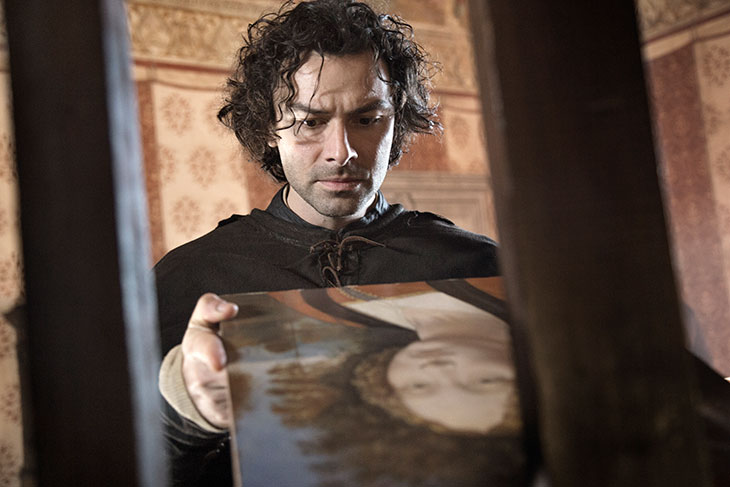I don’t know about you, but during the 500th anniversary of Leonardo’s death in 2019 what for me really seemed to be missing was a schlocky TV drama about the great man. Here, finally, our wish has been granted. Leonardo would seem to follow on from the success of programmes such as The Borgias and Medici: Masters of Florence, both of which are also set in 15th-century Italy. However, what something like Medici had going for it – in the first series at least – was a genuine interest in the political machinations of Renaissance Florence. The same level of interest cannot be found in the world conjured in Leonardo.
The series is set up as a kind of murder mystery. It places us in Milan at the end of the 15th century. Leonardo has been arrested for the murder of his muse, the mostly fictionalised Caterina de Cremona (played by Matilda de Angelis), and the story is told through flashbacks which are interspersed with interrogations led by an entirely fictional Stefano Giraldi (Freddie Highmore). This mixture of mostly real and sometimes invented characters runs throughout the series, alongside occasionally real and mostly invented events. Perhaps the most notable of these is Leonardo’s arrest for sodomy in 1476, the known details of which are closely followed in this episode. An interesting choice is Aidan Turner as an endearingly goofy Leonardo da Vinci. Though he doesn’t seem to have changed his costume, he is very far from his smouldering Poldark. Where we might have expected a tortured genius, Turner’s Leonardo is painfully shy and rather gauche, but all the more likeable for it.
Still from Leonardo (2021), showing the artist-in-training in the studio of Andrea del Verrocchio (played by Giancarlo Giannini)

Any historical drama is necessarily fictional – though a life as interesting as Leonardo’s surely did not need quite so much fabrication – and accuracy of events is not the same as faithfulness to a historical moment (and neither guarantee plausibility). While at key moments Leonardo remembers that it is set in a particular era for the most part it is essentially ahistorical. Despite the vaguely old-looking clothes and some rather obvious green screen shots of Florence, the fact that it this set in the past seems incidental. At one point Leonardo’s triumphant completion of the angel in The Baptism of Christ, which he worked on with his teacher Verrocchio, is celebrated with what looks remarkably like a private view, though instead of champagne the guests are handed beakers of wine. One such guest is the patron Ludovico Sforza who, after staring at the painting for some time, wistfully suggests that ‘perhaps there is more than one narrative in this painting. John is anointing Jesus, and Verrocchio is anointing you as his successor. You are Leonardo.’
Luckily, for a show about Leonardo da Vinci, what it does seem interested in is art, as seen in Sforza’s critical interpretation of the Baptism. In early episodes Verrocchio’s studio is full of his greatest hits: in one shot we see Tobias and the Angel, St Jerome, and a Madonna and Child, all propped up together. In others we see another Madonna and Child, and the Madonna del Latte. With so much of his oeuvre sat about his studio you would be forgiven for thinking that the artist never sold a painting or fulfilled a commission (he did notoriously take his time over them). Nevertheless, their presence is a nice touch, and for the art enthusiast spotting these works is part of the fun.
Still from Leonardo (2021), showing the artist holding his portrait of Ginevra de’ Benci, one of the first-known three-quarter-view portraits in Italian art

Particular works by Leonardo frame each of the episodes and with this we get a few tentative forays into art criticism, which are charming and patronising in equal measure. In the first episode, for example, Verrocchio tells us that there are three kinds of light – direct light, diffused light, and the nearly unpaintable luminescence of the sky. His lecture is met with a lit-up Leonardo rapturously proclaiming ‘Chiaroscuro!’. When Ginevra de Benci (Poppy Gilbert’s performance is one of the real highlights of the series) is sitting for her portrait the viewer is treated to a little iconography lesson. Early on, Leonardo explains to her that portraits are not painted at a three-quarter angle – a pleasing moment of dramatic irony, for we know that the completed painting will be an early example of this emerging style – and later alludes to his choice of plants in the background: ‘It’s a juniper, ginepro.’ In case we hadn’t made the link ourselves, she helpfully replies: ‘Like Ginevra.’ ‘It’s a pun,’ she says, just in case we weren’t quite sure. And for anyone at the back who is still left behind, she continues: ‘a play on my name’.
In this exchange we see the series both at its best and at its worst: the awkward dialogue is a constant feature. At one point Caterina declares, ‘you’re just so selfish, you only care about your art’, and throughout each episode Leonardo (rather gratingly) offers variations on a theme of ‘I can only draw/paint the truth’. But aside from what look like low-budget sets, a clunky script, and variable performances, Leonardo is a very watchable. It is even, at times, rather fun.
Leonardo is available to stream on Amazon Prime Video in the UK and Ireland.



